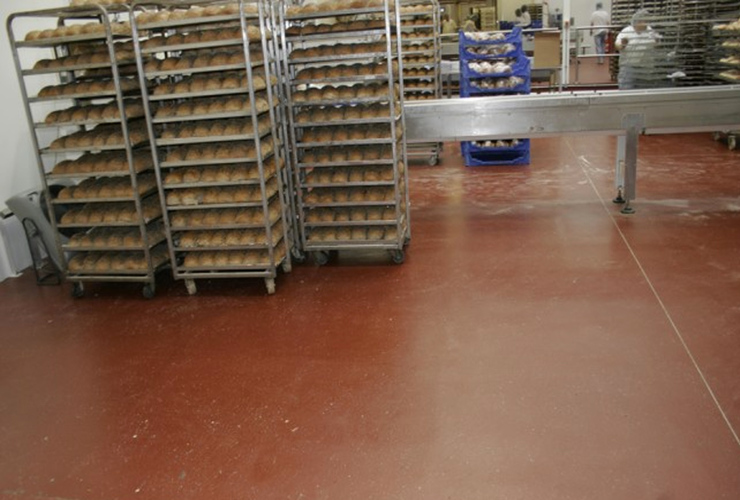Imagine this: You’re preparing a hearty meal, the aroma of simmering spices filling your kitchen. You reach into your pantry for a can of tomatoes, only to find it coated in a mysterious, sticky residue. You pull out a jar of peanut butter, and it, too, bears the same unsettling sign. You’ve been diligent about cleaning, but something’s off. The answer, unfortunately, might be a seemingly innocuous detail: how high your food is stored.

Image: www.epoxyflooring.co.uk
It’s easy to forget about what lurks beneath our floors – things like pests, dust, and even spills that can cling to surfaces. But where our food is stored can have a significant impact on its safety and quality. We’re going to dive into the world of food storage heights, exploring why this seemingly simple factor plays a crucial role in keeping our kitchens and pantries hygienic and our food delicious.
The Science Behind the Inches
The ideal height for food storage is not just a matter of convenience, but also a question of minimizing potential contamination. Here’s why:
-
Pests: The floor is a haven for pests like ants, cockroaches, and rodents. These critters can crawl on surfaces, leaving behind bacteria and allergens that can contaminate food. Elevating food storage off the floor helps create a physical barrier against these unwelcome visitors.
-
Moisture: Even in well-ventilated kitchens, there’s a chance of spills or humidity collecting near the floor. This moisture can create an ideal environment for mold growth, which can compromise food quality and cause potential health problems.
-
Dust: Dust mites, pet dander, and other allergens are constantly circulating in the air. Food stored close to the floor is more susceptible to dust accumulation, which can affect its taste and pose health risks, especially for people with allergies.
-
Cleaning: Keeping food off the floor makes cleaning easier. It allows for thorough sweeping and mopping beneath shelves and cabinets, reducing the chance of dirt, grime, and bacteria accumulating in hard-to-reach areas.
The Storage Height Recommendations
So, what’s the magic number? While there isn’t a universally agreed-upon standard, a general rule of thumb is to store food at least 6 inches off the floor. Here’s why this height is a good starting point:
-
Accessibility: A 6-inch clearance allows for easy access to items, even for those with limited mobility. No more bending and stretching to retrieve those hard-to-reach cans!
-
Visual Clarity: A higher storage height means you can clearly see everything on the shelf, making inventory management simpler. You’ll be less likely to forget about a forgotten can of beans lurking in the back!
-
Air Circulation: A 6-inch gap promotes air circulation, which helps dry any accidental splashes quickly and discourages mold growth.
Beyond the 6-inch Rule: Specific Guidelines
While 6 inches is a good starting point, certain types of food may require additional elevation for enhanced storage safety.
-
Bulk Grains: Grains like rice, pasta, and oats are particularly susceptible to pest invasion. Consider storing them in airtight containers at a minimum of 12 inches off the floor to provide an extra barrier from unwanted pests.
-
Perishable Foods: Foods like meat, poultry, and dairy products need cooler temperatures for optimal freshness. Storing these items in refrigerators or on higher shelves (at least 12 inches from the floor) helps maintain a consistent temperature and avoid accidental spills.
-
Cleaning Supplies: It’s a good idea to store cleaning supplies well above food items, ideally on a separate shelf or in a designated cupboard. This distance minimizes contamination risks from potential spills or droplets.
-
Fridge and Freezer Safety: Keep your refrigerator and freezer base at least 2 inches off the floor for easy cleaning and to prevent moisture buildup. Consider using feet or rollers to raise them.

Image: johnnyholland.org
Expert Insights: The Importance of Routine Inspection
Even with elevated storage, it’s essential to be vigilant about food safety.
-
Dr. Susan Roberts, a registered dietitian and nutrition specialist, emphasizes the importance of regular inspection: “Check your pantry shelves and food storage containers every few weeks to ensure there are no signs of pests, spills, or spoilage. Early detection can prevent a whole lot of trouble.”
-
Dr. Robert B. Gravani, a food safety expert, adds, “Don’t forget about your fridge! Regularly check the shelves and drawers for expired food, leaks, or unusual smells. Keeping your fridge clean is a crucial part of food safety.”
Actionable Tips for a Safe and Efficient Kitchen
Here’s how to put this essential food storage knowledge into practice:
-
Clean Regularly: Schedule regular deep cleaning sessions for your kitchen and pantry to remove crumbs, spills, and dust. This is crucial for keeping pests away and preventing food contamination.
-
Invest in Storage Solutions: Utilize shelves with adjustable height settings or clear containers with airtight lids to ensure optimal food storage.
-
Follow the FIFO Rule: “First in, First out” means always using older food items before newer ones. This minimizes waste and ensures maximum freshness.
How Many Inches Off The Floor Should Food Be Stored
Conclusion: Elevating Food Storage, Elevating Your Health
Food storage is often overlooked, but it’s a critical element of maintaining a safe and hygienic kitchen. While the recommended storage height might seem insignificant, it can significantly affect the quality and safety of your food. By elevating your storage and adopting good hygiene practices, you can minimize the risks of contamination and enjoy the peace of mind that comes with knowing your food is safe and ready to enjoy.
Remember, food safety is an ongoing endeavor. Stay vigilant, inspect your storage areas regularly, and continue to learn about best practices. By following these simple tips, you’ll be taking a proactive step toward safeguarding your health and ensuring that your kitchen is a safe and welcoming space for preparing delicious meals.





